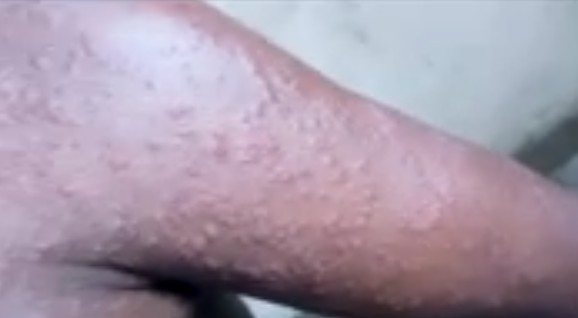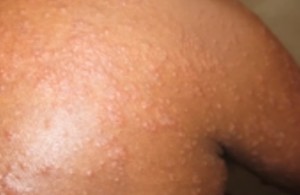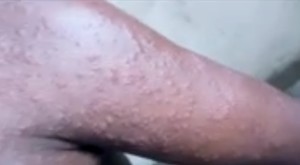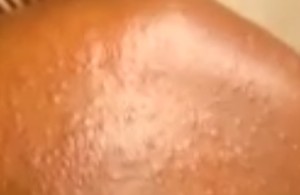Sweat rash, also known as heat rash, prickly heat, or miliaria is a skin disease that manifests in small and itchy rashes. This rash can affect anyone including babies and adults. It is especially found occurring during hot humid weather. Sweat rash develops when the pores or sweat ducts are blocked and trap perspiration under skin. Heat rash usually clears on its own, but when it becomes severe, one may need to see a doctor. This condition may also be caused by a yeast or Candida that is found naturally occurring on your skin.
Trapped perspiration may at times cause an imbalance on skin, which allows Candida to trigger an irritating and itchy rash, which appears red. It is not easy to know when this rash will develop because people sweat every day considering that you are likely to indulge in activities, which cause a lot of sweating like gym or exercising.
The everyday activities, which make you sweat, could lead to such common skin infection. The condition affects areas of body where sweat appears most and the skin rubs against each other such as the under arms, groin, backs of knees, and under breasts.
Causes of sweat rash
When the sweat ducts clog, the perspiration, instead of evaporating is trapped beneath skin thereby causing inflammation and rash. Although it is not clear why the ducts clog, some skin infections are believed to cause the clogging such as Candida. There are factors, which are also associated with the blockage of sweat ducts.
An individual who has immature sweat ducts is likely to experience this rash. A newborn’s sweat ducts may not be fully developed and they could rupture easily thus trapping perspiration beneath the baby’s skin. Prickly heat develops in babies, especially in the first few weeks of life when the infants are warmed in an incubator or dressed warmly.
An infant who has fever may also develop the rash. Another possible cause is topical climate. The hot, humid weather is likely to induce a lot of sweating which may cause the miliaria. Intensive physical activities such as hard work and exercising are associated with this skin rash because they cause one to sweat heavily.
Overheating in general especially when one dresses too warmly or sleeps under an electric blanket may cause the rash. Having prolonged bed rest makes people to develop prickly rash particularly, those with fever.
Symptoms of sweat rash or pricky heat rash
A person with prickly heat may show symptoms such as a sore red rash. The skin may be inflamed and itchy. There is a burning sensation that causes discomforts. The skin may also break and become moist.
The rash is mainly found in skin folds and areas, which tend to experience skin rubbing and therefore it affects parts such as the elbows, back of knees, grain, between and under breasts, as well as under the arms. In infants, the rash is mainly found in neck, chest, and shoulders, armpits, and elbow creases.
Types of sweat rash or miliaria
There are different forms of miliaria or sweat rash and they include miliaria crystalline, which is the mildest form of the condition. This affects sweat ducts found in top layer of skin. The condition is marked by some clear fluid filled blisters as well as papules or bumps which tend to break easily.
Another type is the miliaria rubra, which occurs deeper in skin and is sometimes referred to as the prickly heat. It manifests in form of red bumps that are itchy and prickly. Miliaria pustulosa occurs when the fluid containing sacs called vesicles occurring in miliaria rubra are inflamed and filled with pus forming pustular.
There is also a less common form of sweat rash and it is called miliaria profunda, which affects mainly the dermis or the deeper layer or skin. The retained sweat will leak out of the sweat gland and get into the skin thus causing firm and flesh colored lesions resembling goose bumps.
Treatment of sweat rash
While there is no reason why prickly heat should cause long term discomforts, if it so does, you should seek a medical doctor. Prickly heat isn’t a serious condition and in most cases, it may not require any specific treatment. It will disappear on its own in a few days. Nonetheless, there are a number of things, which one could observe to help ease the symptoms.
For example, an individual should try avoiding excessive heat and humid. You can spend time in shade or have a small fan if you are going outside. More sweating can make the condition to worsen. Also, wear loose cotton clothing, which tend to absorb sweat and refrain from wearing synthetic fiber clothes or those made of nylon and polyesters, as they do not help in absorbing sweat and clearing it from skin pores.
Keeping the skin cool may also help. You can take a cool shower or bath and sooth the skin. Staying in air-conditioned spaces may also help cool the skin and prevent excessive sweating of body. While you may want to use cold compress, you should not leave the ice for too long on skin.
Calamine lotion can help in soothing sores and irritation on skin while hydrocortisone cream is helpful in treating itchy and irritated skin. Antihistamine tables can be used to control itching but make sure you consult with your doctor first before you use any medicine.




